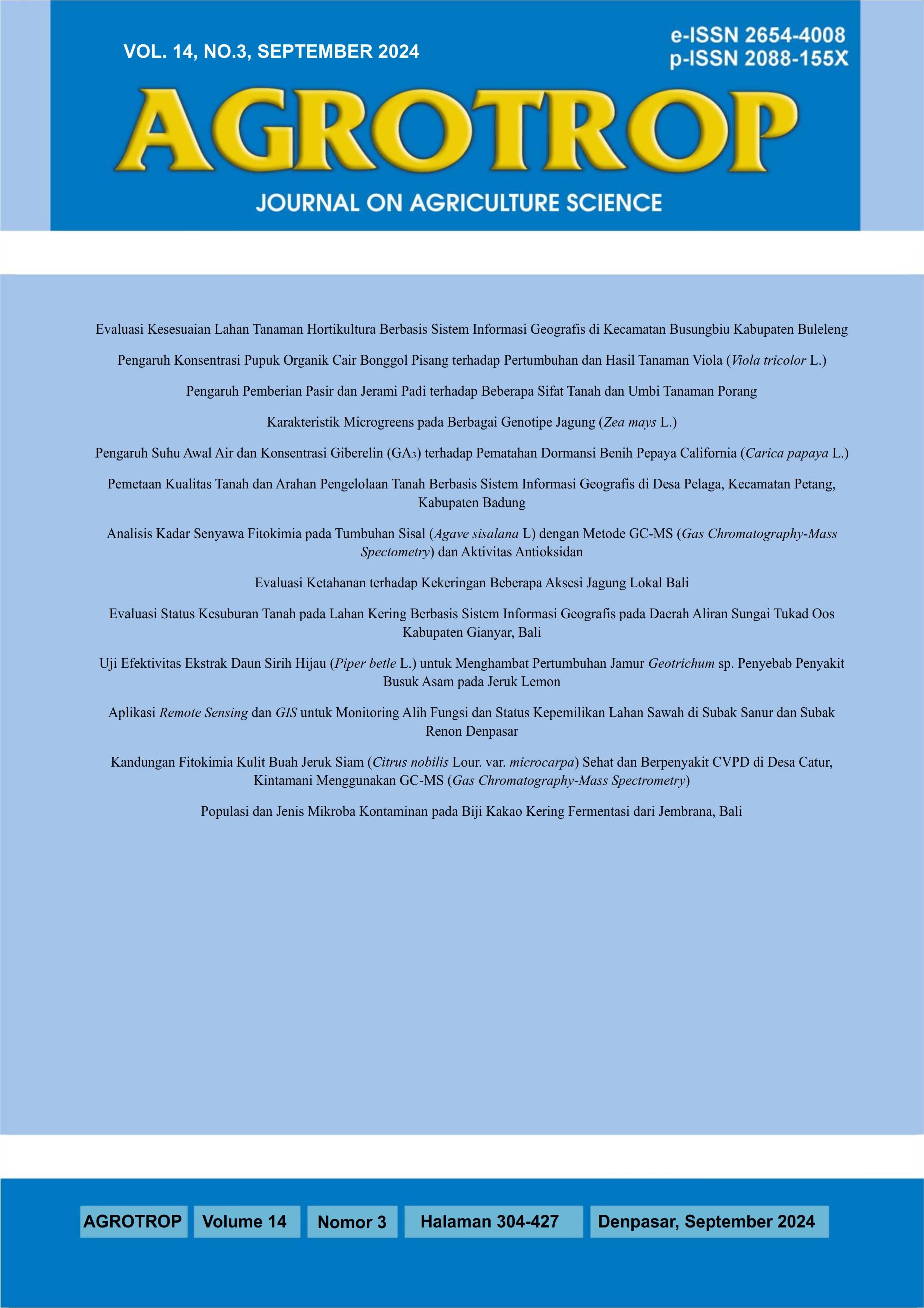Karakteristik Microgreens pada Berbagai Genotipe Jagung (Zea mays L.)
Abstract
Characteristics of Microgreen in Different Genotypes of Maize (Zea mays L.). Microgreen is one of the plant cultivation techniques that can be done in accordance with the concept of urban farming. Plants that are still rarely cultivated as microgreens are corn. Corn microgreens have the main bioactive content, namely carotenoids. Microgreen characteristics of different corn genotypes are not yet known. This study aimed to determine the characteristics of microgreens and determine the superior attributes of corn genotypes cultivated as microgreens. This study used a one-factor completely randomized design (CRD) of 8 levels and 3 replications. The levels used were various corn genotypes i.e. local corn Belok Sidan, local corn Seraya, hybrid corn Pertiwi, hybrid corn Pioneer, sweet corn Bonzana F1, sweet corn Talenta, sticky corn Kumala, and sticky corn Paramita. The results showed that different corn genotypes had different characteristics on the observed variables. Hybrid corn Pertiwi and sticky corn Paramita had superior attributes in the organoleptic test in terms of crispness (3.50; 3.06), flavor (3.47; 2.75), level of liking (2.94; 2.94), and total soluble solids (12.7°brix and 14.3°brix, respectively), local corn Seraya had superior characteristics in carotenoid content (45.42 mg/100g), and local corn Belok Sidan had superior characteristics in fresh weight and dry weight (3.6798 g and 0.4874 g).
Downloads
References
Budi, R. S., Indarwati, Resti F., M. Asril., Riana, J., Purwaningsih, E. J., Evan, P. R., dan Arsi. 2021. Teknologi Produksi Benih. Diedit oleh: Abdul Karim.
Buntoro, B. H., Rogomulyo, R., dan Trisnowati, S. 2014. Pengaruh Takaran Pupuk Kandang dan Intensitas Cahaya Terhadap Pertumbuhan dan Hasil Temu Putih (Curcuma zedoaria L.). Vegetalika, 3(4):29–39.
Chrisnawati, L., Dzul, F., dan Dewi M. S. 2022. Pelatihan Budidaya Microgreens Sebagai Alternatif Urban Farming. Community Development Journal, 3(2):644-648.
Cody. 2019. The Secret to Growing Sweet Corn Microgreens. https://thistledownsfarm.com/the-secret-to-growing-sweet-corn-microgreens/. (accesed 30 Oktober 2023).
Gofar, N., Tri P. N., Shinta D. I. P., dan Neni, S. 2022. Teknik Budidaya Microgreens. Palembang-Indonesia.
Koley, T. K. and Maurya, A. (2016). Microgreens From Vegetables : More Nutrition For Better Health . New Ages Protected Cultivation, 2(2): 25-27.
Mirah, A.A.I. 2020. Analisis Kandungan Klorofil pada Beberapa Jenis Sayuran Hijau Sebagai Alternatif Bahan Dasar Food Suplement. Jurnal Emasains: Jurnal Edukasi Matematika dan Sains, 9(2):171 – 176.
Nurhasanah. 2017. Uji Potensi Senyawa Antikanker Ekstrak Metanol Lima Spesies Microgreens Serealia. Digital Library UIN Sunan Gunung Djati. https://etheses.uinsgd.ac.id/44617/. (accesed 12 September 2023).
Putra, C. N. (2018). Kajian Konsentrasi Pelarut dan Lama Waktu Ekstraksi yang Bervariasi Terhadap Karakteristik Ekstrak Karotenoid dari Jagung Manis. Skripsi, Univesitas Pasundan.
Rahayu, E., Widajati, E. 2007. Pengaruh Kemasan, Kondisi Ruang Simpan terhadap Viabilitas benih Caisin (Brassica chinensis L.). Buletin Agronomi, 35(3)197-196.
Rizkiyah, Noor., Prasmita, D.W., Fatchur, R. 2022. Mcrogreens Sebagai Alternatif Budidaya Tanaman Pertanian Urban. Prosiding Seminar Nasional Magister Agribisnis, 3(1):21 – 27.
Salim, M.A. 2021. Budidaya Microgreens: Sayuran Kecil Kaya Nutrisi dan Menyehatkan. Diedit oleh: Setiawan, D. Penerbit: Yayasan Lembaga Pendidikan dan Pelatihan Multiliterasi. Bandung.
Smit, K., de Brabander, C. J., Boekaerts, M., & Martens, R. L. (2017). The self-regulation of motivation: Motivational strategies as mediator between motivational beliefs and engagement for learning. International Journal of Educational Research, 82: 124–134.
Syukri, D. 2021. Pengetahuan Dasar Tentang Senyawa Karotenoid Sebagai Bahan Baku Produksi Produk Olahan Hasil Pertanian. Andalas University Press, Padang.
Xiao, Z., Lester, G. E., Luo, Y., and Wang, Q. 2012. Assesment of Vitamin and Carotenoid Concentrations of Emerging Food Product: Edible Microgreens. Jurnal of Agricultural and Food Chemistry, 60(31):7644-7651.
Xiao, Z., Rausch, S., Luo, Y., Sun, J., Yu, L., Wang, Q., & Chen, P. 2018. Microgreens of Brassicaceae : Genetic Diversity of Phytochemical Concentrations and Antioxidant Capacity. Elsevier, 101:731 – 737.











